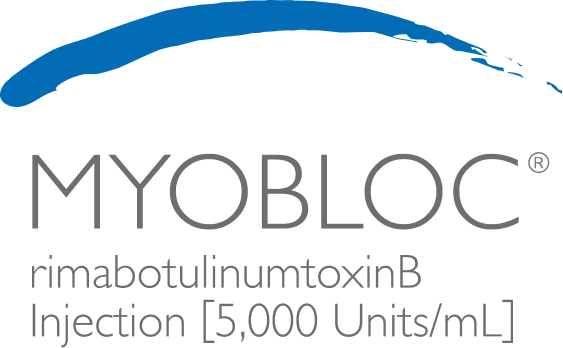What patient types are
right for MYOBLOC?


Whether you are a frequent injector or a new injector of MYOBLOC®, see possible patient types who could be appropriate to treat with MYOBLOC.
-

Jim, 74, Has Cervical Dystonia
Meet Jim, who was diagnosed with cervical dystonia 10 years ago. Jim is no longer feeling relief from his botulinum toxin-A injections as his neck is tightening more lately, affecting his mobility.
 Download Profile
Download Profile
-

Lydia, 44, Has Cervical Dystonia
Meet Lydia, a patient with cervical dystonia. Over the past 4 years, she has experienced gradually worsening twisting of her neck with pain, with limited relief from physical intervention and oral medication.
 Download Profile
Download Profile
-

Ryan, 39, Has Cervical Dystonia
Meet Ryan, a patient who has experienced 6 months of pain and tightness in his neck due to cervical dystonia. Even after a year of physical therapy, he’s been unable to find relief.
 Download Profile
Download Profile
-

Gwen, 71, Has Cervical Dystonia
Meet Gwen, an active grandmother who has been experiencing persistent neck pain and tightness. Her primary care physician referred her to a physical therapist with the goal to find relief.
 Download Profile
Download Profile
-

Donna, 68, Has Chronic Sialorrhea
Meet Donna, a patient recently experiencing chronic sialorrhea from Parkinson's disease. She admitted to feeling self-conscious about the drooling.
 Download Profile
Download Profile
-

Charles, 72, Has Chronic Sialorrhea
Meet Charles, a patient with advanced Parkinson’s disease and diagnosed with chronic sialorrhea 2 years ago. His chronic sialorrhea affects his speech to loved ones.
 Download Profile
Download Profile
For cervical dystonia in adults
Dosing and administration
recommendations for
cervical dystonia1
For cervical dystonia in adults


Whether you need a refresher on dosing ranges or want to gain a better understanding of the injection process, here are some resources to guide you every step of the way.


Initial dosing recommendations for affected muscles1
Recommended initial total dose to be divided among affected muscles:
- Patients with a prior history of tolerating botulinum toxin injections is 2,500 to 5,000 Units
- Patients without a prior history of tolerating botulinum toxin injections should receive a lower initial dose
- Subsequent dosing should be optimized according to the patient’s response




Proven, versatile, and requires no mixing1
With no reconstitution required, MYOBLOC® is syringe-ready and available in 3 vial sizes for single-patient use. For injection, you'll need a suitable sterile needle (eg, 30-gauge, 0.5 inch) and alcohol swabs.
IMPORTANT SAFETY INFORMATION WARNINGS AND PRECAUTIONS
Lack of Interchangeability Between Botulinum Toxin Products
The potency units of MYOBLOC are specific to the preparation and biological activity assay method utilized. Due to differences in the aspects of this assay such as the vehicle, dilution scheme, and laboratory protocols for various potency assays, potency units are not interchangeable with other preparations of botulinum toxin products and, therefore, units of biological activity of MYOBLOC cannot be compared to or converted into units of any other botulinum toxin products assessed with any other specific assay method.
Download these MYOBLOC guides for your office
Cervical Dystonia Injection Guide
This guide offers detailed instructions for injecting MYOBLOC for the treatment of cervical dystonia.
Cervical Dystonia Anatomical Guide
This guide helps you keep a record of where your patient’s injections should be administered and the dosage strength used for the treatment of cervical dystonia.
No Mixing Guide
This guide provides dosing instructions, recommendations, and considerations for the only botulinum toxin that doesn’t require mixing, MYOBLOC.
Order MYOBLOC
If you're ready to get started with MYOBLOC, get in touch with us and we'll make the ordering process simple for you.


For Chronic Sialorrhea in adults
Dosing and administration
recommendations for
chronic sialorrhea1
For Chronic Sialorrhea in adults


Whether you need a refresher on dosing ranges or want to gain a better understanding of the injection process, here are some resources to guide you every step of the way.


Guidelines for anatomical landmarks1
- Parotid gland injection
- Bisect the distance between the tip of the tragus (Site A) and the angle of the mandible (Site B)
- Inject 1 finger breadth anterior to this site (Injection Site 1)
- Submandibular gland injection
- Bisect the distance between the angle of the mandible (Site B) and the tip of the chin (Site C)
- Inject 1 finger breadth medial to the inferior surface of the point of bisection (Injection Site 2)




Proven, versatile, and requires no mixing1
With no reconstitution required, MYOBLOC is syringe-ready and available in 3 vial sizes for single-patient use. For injection, you'll need a suitable sterile needle (eg, 30-gauge, 0.5 inch) and alcohol swabs.
IMPORTANT SAFETY INFORMATION WARNINGS AND PRECAUTIONS
Lack of Interchangeability Between Botulinum Toxin Products
The potency units of MYOBLOC are specific to the preparation and biological activity assay method utilized. Due to differences in the aspects of this assay such as the vehicle, dilution scheme, and laboratory protocols for various potency assays, potency units are not interchangeable with other preparations of botulinum toxin products and, therefore, units of biological activity of MYOBLOC cannot be compared to or converted into units of any other botulinum toxin products assessed with any other specific assay method.
Dosing recommendation1
- Subsequent dosing and frequency of dosing should be optimized according to the patient’s individual response
- Generally, no more frequent than every 12 weeks
- Individual patient responses may vary
Dosing considerations1
- Sialorrhea symptom severity
- Risk of dysphagia—patients with neuromuscular disorders should be monitored closely for severe swallowing or breathing difficulty
Download these MYOBLOC guides for your office
Chronic Sialorrhea Injection Guide
This guide offers detailed instructions for injecting MYOBLOC for the treatment of chronic sialorrhea.
Chronic Sialorrhea Anatomical Guide
This guide helps you keep a record of where your patient’s injections should be administered and the dosage strength used for the treatment of chronic sialorrhea.
No Mixing Guide
This guide provides dosing instructions, recommendations, and considerations for the only botulinum toxin that doesn’t require mixing, MYOBLOC.
Order MYOBLOC
If you're ready to get started with MYOBLOC, get in touch with us and we'll make the ordering process simple for you.


Access and
coverage resources


Find information on our co-pay program as well as our patient assistance program to help your patients access and save on MYOBLOC®.


Patient Support Brochure
Share this brochure with your patients to help them better understand what to expect with MYOBLOC treatment and how to save.
How To Save On MYOBLOC Treatment
If financial assistance in obtaining MYOBLOC treatment is needed, there are programs for eligible patients. With the MYOBLOC CO-PAY PROGRAM, eligible patients could receive up to $4,000 each year to help with out-of-pocket expenses for MYOBLOC treatment.
MYOBLOC Co-Pay Program
-
Patients who:
- Are 18 years or older and legal US residents
- Have commercial insurance coverage
- Are diagnosed with cervical dystonia (CD) or chronic sialorrhea (CS)
- Are NOT enrolled in a government insurance plan (eg, Medicare, Medicaid, TRICARE®, or other federal or state-funded programs)
-
- Any size vial of MYOBLOC
- Injection procedure costs
- Injection guidance costs—Ultrasound or EMG
- Note: Residents of Michigan, Rhode Island, and Minnesota are not eligible for injection procedure or injection guidance costs
-
Speak to your healthcare provider. They will submit an enrollment form on your behalf in their online portal, or by mail or fax.
- No financial requirements
Financial assistance may be available to those who qualify. Talk to your patients to determine eligibility.
Take the next step with MYOBLOC
-

Order MYOBLOC
Order MYOBLOCOrder by phone or email and we'll help you get the treatment your patients need.
-

Get Live Support
Request A SpecialistGet in touch with a Reimbursement Specialist who can help you navigate patient support services, insurance benefits, and more.
-

Access Resources
View ResourcesFind resources that can help guide you through the process of injecting MYOBLOC.
